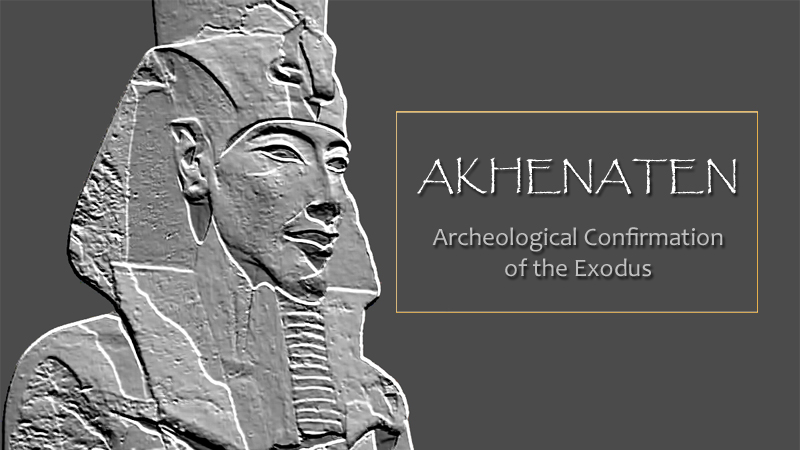 I have a special subject related to the Exodus account this week. I trust that it will be encouraging to you.
I have a special subject related to the Exodus account this week. I trust that it will be encouraging to you.
AHKENATEN
Since we are studying about the Exodus of Israel out of Egypt, I want this week to write about what I believe is an archeological confirmation of the Exodus. I will recount the story of a unique pharaoh of Egypt named Akhenaten. His story has been preserved for about 3500 years and revealed in our generation. This puts Akhenaten’s revelation in the same category as the “Dead Sea Scrolls” which served to counter scholastic charges against the accuracy of the Bible (due to supposed copying errors). This occurred also in our generation.
During the confrontation leading up to the Exodus, God specifically judged (humiliated) the gods of Egypt. Of course, everyone knows that the final and most devastating judgment on Egypt leading to the Exodus was the death of the firstborn of every household in Egypt. This was true from the Pharaoh to the most humble servant. We propose that the Pharaoh known today as Akhenaten was the second born son of the Pharaoh of the Exodus. We believe that he personally witnessed the successive judgments brought on Egypt and finally of his older brother’s death on the night of the Passover. We believe that these events occurred relatively early in his father’s reign so it would be several years before he would become Pharaoh. When he did, he made dramatic changes in the religious life in Egypt, converting from polytheism to a monotheistic system of belief. This reflected what he had experienced during the Exodus.
The Biblical dating for the Exodus is based on one Scripture: I Kings 6:1
“Now it came about in the four hundred and eightieth year after the sons of Israel came out of the land of Egypt, in the fourth year of Solomon’s reign over Israel, in the month of Ziv which is the second month, that he began to build the house of the Lord.” (I Kings 6:1)
We are considering specific dates of events that occurred 3000 years ago. As a result, there is considerable disagreement concerning the dates of Solomon’s reign. I have chosen the 40 year period from 971 – 931 BC/BCE. The fourth year of Solomon’s reign then would be 967 which would place the Exodus at 1447 BC/BCE. This date is based solely on the Biblical reference cited above and is much earlier than that set forth by most liberal scholars.
For the purposes of this article, I am using an article published many years ago in the Biblical Archaeological Review (May-June 1987). The list of Pharaoh’s of the 18th Dynasty are as follows:
Thutmose III 1504-1451
Hatshepsut 1502-1483 (co-regent with Thutmose III)
Amenophis II 1453-1426
Thutmose IV 1426-1416
Amenophis III 1416-1377
Amenophis IV 1377-1360 (Amenophis IV changed his name to Akhenaten)
The gap between the beginning of Akhenaten’s father reign (1416) and the Biblical date of the Exodus (1447) is only 31 years. The dates of Solomon’s reign and the chronology of the 18th Dynasty of Egypt are not precisely determined, therefore, it does not seem to me to be unreasonable to believe that the reign of Akhenaten’s father and the Exodus coincide.
When Akhenaten began to reign he made incredible changes in the religious system of Egypt. He declared that all of the gods of Egypt had ceased to be operative, therefore, he closed the temples to these god. He declared that there was only one god whom he called Aten. According to Akhenaten, Aten lived in heaven and was self-existent. Aten was the creator and the source of light and life. Aten had humiliated all of the gods of Egypt. Akhenaten spent his reign in glorifying Aten. He built a new city dedicated to Aten. He had elaborate and extensive stone reliefs made depicting the works of Aten.
After the death of Akhenaten and his immediate successors, the subsequent pharaoh, Horemheb, destroyed all of the works of Akhenaten. The massive stone works depicting Aten and Akhenaten were broken up and used for fill material in new construction. Egypt returned to the polytheism that had characterized the period before Akhenaten. Akhenaten and his god were forgotten and any memorial to Aten was destroyed.
This brings us to the modern era. In the 1800’s archaeologists who were excavating the structures built by Horemheb, began to find pieces of the destroyed stonework from the time of Akhenaten. Thousands of pieces were found but there seemed to be no way to reassembled them to tell their story. Then in 1965 a retired Foreign Service worker, Ray Winfield Smith, used photography and computer matching to begin to reassemble the broken pieces of stonework. As he did so, the story of Akhenaten emerged.
So in the era when the nation of Israel appeared again after 2000 years and the validity of the Bible was confirmed by the “Dead Sea Scrolls”, a powerful witness to the Exodus has been presented to our generation. In most cases I would say that “God is subtle”. He acts leaving little physical evidence so only eyes of faith behold His works. Sometimes, He openly declares His works for all to see. We are blessed to be a generation to whom He is openly declaring His works.